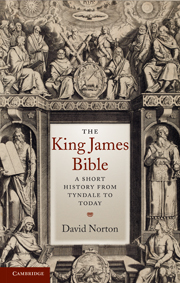Book contents
- Frontmatter
- Contents
- List of illustrations
- Preface
- List of abbreviations
- 1 Predecessors
- 2 Drafting the King James Bible
- 3 ‘I was a translator’
- 4 Working on the King James Bible
- 5 1611: the first edition
- 6 Printing, editing and the development of a standard text
- 7 Reputation and future
- Select bibliography
- Index
4 - Working on the King James Bible
Published online by Cambridge University Press: 05 June 2012
- Frontmatter
- Contents
- List of illustrations
- Preface
- List of abbreviations
- 1 Predecessors
- 2 Drafting the King James Bible
- 3 ‘I was a translator’
- 4 Working on the King James Bible
- 5 1611: the first edition
- 6 Printing, editing and the development of a standard text
- 7 Reputation and future
- Select bibliography
- Index
Summary
SETTING UP
By 1604, the idea that a new translation was needed had been around for some time, though perhaps only held strongly by Hugh Broughton. The Bishops' Bible had not succeeded in ousting Geneva as the popular favourite, so England was in the uncomfortable position of using two different Bibles, one the official Bible of the Church, the other generally used by the people and many of the clergy, including the man principally reponsible for the demise of Geneva, the future Archbishop William Laud. Variety of translation had been defended and even extolled by the English translators from Coverdale onwards, but it was a touchy point, especially in controversy with Roman Catholics. It seemed that England did not have the pure truth of the Bible, and there was an uncomfortable awareness of errors in both versions, especially in the Bishops' Bible.
Broughton agitated long and hard for a new version. To him any Bible that had inconsistencies in chronology ‘will as it were rend the Bible in pieces, whereby it should become of no estimation’. By contrast, ‘a Bible fair printed, standing in the original, or translated with pure dexterity, is the glory of all books’: it would settle ‘all the stories in order, that no one jar, and all appear chained [linked] with manifold golden chains of times’.
- Type
- Chapter
- Information
- The King James BibleA Short History from Tyndale to Today, pp. 81 - 110Publisher: Cambridge University PressPrint publication year: 2011



